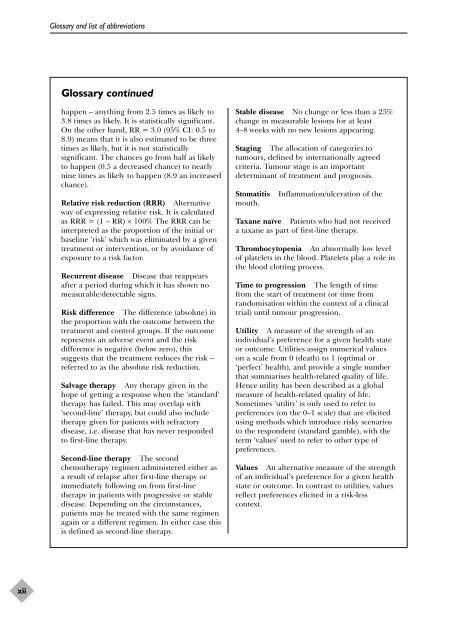Docetaxel with prednisone or prednisolone for the treatment of ...
Docetaxel with prednisone or prednisolone for the treatment of ...
Docetaxel with prednisone or prednisolone for the treatment of ...
You also want an ePaper? Increase the reach of your titles
YUMPU automatically turns print PDFs into web optimized ePapers that Google loves.
xii<br />
Glossary and list <strong>of</strong> abbreviations<br />
Glossary continued<br />
happen – anything from 2.5 times as likely to<br />
3.8 times as likely. It is statistically significant.<br />
On <strong>the</strong> o<strong>the</strong>r hand, RR = 3.0 (95% CI: 0.5 to<br />
8.9) means that it is also estimated to be three<br />
times as likely, but it is not statistically<br />
significant. The chances go from half as likely<br />
to happen (0.5 a decreased chance) to nearly<br />
nine times as likely to happen (8.9 an increased<br />
chance).<br />
Relative risk reduction (RRR) Alternative<br />
way <strong>of</strong> expressing relative risk. It is calculated<br />
as RRR = (1 – RR) × 100% The RRR can be<br />
interpreted as <strong>the</strong> prop<strong>or</strong>tion <strong>of</strong> <strong>the</strong> initial <strong>or</strong><br />
baseline ‘risk’ which was eliminated by a given<br />
<strong>treatment</strong> <strong>or</strong> intervention, <strong>or</strong> by avoidance <strong>of</strong><br />
exposure to a risk fact<strong>or</strong>.<br />
Recurrent disease Disease that reappears<br />
after a period during which it has shown no<br />
measurable/detectable signs.<br />
Risk difference The difference (absolute) in<br />
<strong>the</strong> prop<strong>or</strong>tion <strong>with</strong> <strong>the</strong> outcome between <strong>the</strong><br />
<strong>treatment</strong> and control groups. If <strong>the</strong> outcome<br />
represents an adverse event and <strong>the</strong> risk<br />
difference is negative (below zero), this<br />
suggests that <strong>the</strong> <strong>treatment</strong> reduces <strong>the</strong> risk –<br />
referred to as <strong>the</strong> absolute risk reduction.<br />
Salvage <strong>the</strong>rapy Any <strong>the</strong>rapy given in <strong>the</strong><br />
hope <strong>of</strong> getting a response when <strong>the</strong> ‘standard’<br />
<strong>the</strong>rapy has failed. This may overlap <strong>with</strong><br />
‘second-line’ <strong>the</strong>rapy, but could also include<br />
<strong>the</strong>rapy given f<strong>or</strong> patients <strong>with</strong> refract<strong>or</strong>y<br />
disease, i.e. disease that has never responded<br />
to first-line <strong>the</strong>rapy.<br />
Second-line <strong>the</strong>rapy The second<br />
chemo<strong>the</strong>rapy regimen administered ei<strong>the</strong>r as<br />
a result <strong>of</strong> relapse after first-line <strong>the</strong>rapy <strong>or</strong><br />
immediately following on from first-line<br />
<strong>the</strong>rapy in patients <strong>with</strong> progressive <strong>or</strong> stable<br />
disease. Depending on <strong>the</strong> circumstances,<br />
patients may be treated <strong>with</strong> <strong>the</strong> same regimen<br />
again <strong>or</strong> a different regimen. In ei<strong>the</strong>r case this<br />
is defined as second-line <strong>the</strong>rapy.<br />
Stable disease No change <strong>or</strong> less than a 25%<br />
change in measurable lesions f<strong>or</strong> at least<br />
4–8 weeks <strong>with</strong> no new lesions appearing.<br />
Staging The allocation <strong>of</strong> categ<strong>or</strong>ies to<br />
tumours, defined by internationally agreed<br />
criteria. Tumour stage is an imp<strong>or</strong>tant<br />
determinant <strong>of</strong> <strong>treatment</strong> and prognosis.<br />
Stomatitis Inflammation/ulceration <strong>of</strong> <strong>the</strong><br />
mouth.<br />
Taxane naïve Patients who had not received<br />
a taxane as part <strong>of</strong> first-line <strong>the</strong>rapy.<br />
Thrombocytopenia An abn<strong>or</strong>mally low level<br />
<strong>of</strong> platelets in <strong>the</strong> blood. Platelets play a role in<br />
<strong>the</strong> blood clotting process.<br />
Time to progression The length <strong>of</strong> time<br />
from <strong>the</strong> start <strong>of</strong> <strong>treatment</strong> (<strong>or</strong> time from<br />
randomisation <strong>with</strong>in <strong>the</strong> context <strong>of</strong> a clinical<br />
trial) until tumour progression.<br />
Utility A measure <strong>of</strong> <strong>the</strong> strength <strong>of</strong> an<br />
individual’s preference f<strong>or</strong> a given health state<br />
<strong>or</strong> outcome. Utilities assign numerical values<br />
on a scale from 0 (death) to 1 (optimal <strong>or</strong><br />
‘perfect’ health), and provide a single number<br />
that summarises health-related quality <strong>of</strong> life.<br />
Hence utility has been described as a global<br />
measure <strong>of</strong> health-related quality <strong>of</strong> life.<br />
Sometimes ‘utility’ is only used to refer to<br />
preferences (on <strong>the</strong> 0–1 scale) that are elicited<br />
using methods which introduce risky scenarios<br />
to <strong>the</strong> respondent (standard gamble), <strong>with</strong> <strong>the</strong><br />
term ‘values’ used to refer to o<strong>the</strong>r type <strong>of</strong><br />
preferences.<br />
Values An alternative measure <strong>of</strong> <strong>the</strong> strength<br />
<strong>of</strong> an individual’s preference f<strong>or</strong> a given health<br />
state <strong>or</strong> outcome. In contrast to utilities, values<br />
reflect preferences elicited in a risk-less<br />
context.
















